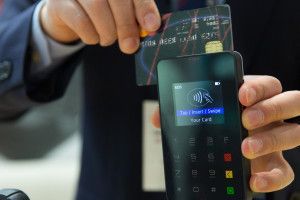Should We Become a Cashless Society?

Over the past century, technology has revolutionized the way we pay for goods and services. From painstakingly counting out coins by the checkout in order to purchase a pint of milk, to buying a brand new Mercedes with a single tap of a thin piece of plastic on a
card reader
.
American consumers now use cash in only 26% of purchases , and this figure is falling every year. There are many more convenient ways to pay for things, and the act of carrying cash around now seems archaic and outdated. Contactless debit cards and mobile apps allow us to pay for items without a second thought while keeping our money and personal data secure at the same time.
Only a few years ago, services like vending machines and taxicabs required you to pay with cash, but now it’s more difficult to find one that will accept your dirty pennies. It’s clear that we are rapidly moving away from a reliance on physical currency, but will we ever become a truly cashless society?
There are several implications of a cashless society, only some of which are positive. To determine whether it is a good idea to become completely cashless, it is worthwhile to delve into the pros and cons.
The pros of a cashless society
- It’s cheaper: Manufacturing and distributing cash costs the US government $877.2 million each year . And it’s the taxpayer who ends up bearing the weight of this cost.
- It is sustainable: Getting rid of cash means fewer resources wasted on the production and distribution of currency.
- It reduces crime: Cash is untraceable, making it easier for people to engage in tax avoidance scams and accept cash in hand payments. As a result, a great deal of tax revenue is lost. When all money is digital, every transaction can be traced, thus reducing financial crime. Businesses will no longer store cash on-site, which will undoubtedly lead to a reduction in robberies and burglaries.
- It is more convenient: Paying for goods and services digitally is considerably quicker and more efficient than dealing with cash. Consumers no longer have to carry around notes and coins wherever they go, and queuing times will be dramatically reduced.
- It is cleaner: In light of the coronavirus pandemic, it has become apparent that handling and exchanging cash is unhygienic and can transmit germs. Going cashless will eliminate health risks.
- It is more secure (in some ways): Stolen cash is gone forever, but it is easy to trace digital transactions and get your money back if you have been a victim of online fraud.
The cons of a cashless society
- It can lead to bad spending habits: When you can make expensive purchases with a single click, people may become less aware of their cash flow and compulsive spending habits.
- It is less social: Paying with cash requires interaction with cashiers and retail staff. Digital finance removes the social side of payment and leaves a simple, emotionless transaction.
- It is LESS secure (in some ways): Digital payment makes us more vulnerable to technical failures, online hackers, and cyberattacks.
- It is threatening the high-street: Digital payment has led to a rise in online shopping, which threatens physical stores and forces them to close down.
Although it will lead to a much more sustainable and reliable form of currency, going cashless will present a few risks that must be managed if we are to completely abandon physical money.


